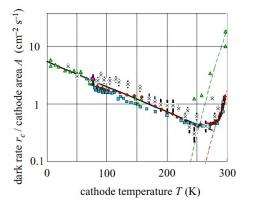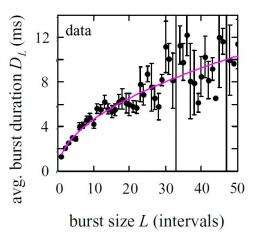March 10, 2010 feature
Cryogenic electron emission phenomenon has no known physics explanation

(PhysOrg.com) -- At very cold temperatures, in the absence of light, a photomultiplier will spontaneously emit single electrons. The phenomenon, which is called "cryogenic electron emission," was first observed nearly 50 years ago. Although scientists know of a few causes for electron emission without light (also called the dark rate) - including heat, an electric field, and ionizing radiation - none of these can account for cryogenic emission. Usually, physicists consider these dark electron events undesirable, since the purpose of a photomultiplier is to detect photons by producing respective electrons as a result of the photoelectric effect.
In a recent study, Hans-Otto Meyer, a physics professor at Indiana University, has further investigated cryogenic electron emission by performing experiments that show how the electron firings are distributed in time. His results reveal that electrons are emitted in bursts that occur randomly, although within a burst the electrons are emitted in a peculiar, correlated way. He suggests that the correlations indicate some kind of trapping mechanism, but the unusual behavior is inconsistent with any spontaneous emission processes currently known. At least at the moment, there seems to be no physics explanation of the observations.
“Cryogenic emission is a physics phenomenon that defies an explanation,” Meyer told PhysOrg.com. “The physics responsible for it may or may not be fundamental, only the future will tell. Photomultipliers happen to offer the environment in which the phenomenon may be observed, but I doubt if my work will be of great significance to the users of photomultipliers.”
In his experiments, Meyer placed a photomultiplier inside an empty container, which he then submerged in liquid nitrogen or helium. Using radiation cooling, he cooled the photomultiplier to a temperature of 80 K (-193° C) after about one day, and to 4 K (-269° C) in another day. With this setup, he could detect cryogenic dark events, which are shown to be caused by single electrons emitted from the cathode of the photomultiplier.
As previous research has shown, starting from room temperature, the dark rate decreases as temperature decreases, but only up to a point. Below about 220 K (-53° C), the dark rate levels off. With further cooling, it begins to rise, and continues to increase at least down to 4 K (-269° C), the lowest temperature for which Meyer has data. Most of Meyer’s experiments were performed at around 80 K (-193° C).
In his experiments, Meyer found that electrons are emitted in “bursts” - numerous electron firings that occur close together in time. Although these bursts occur randomly, they last for different lengths of time, with their duration distribution following a power law. Further, Meyer found that the individual firing events within a burst are highly correlated. Specifically, within a burst, events first occur rapidly, and then less and less frequently as the burst “fades away.”

Perhaps this last observation of progressively longer intervals between firing events within a burst is the most interesting. Meyer suggests that this peculiar distribution of events could be the result of a trapping mechanism. If caught in a trap, an electron could either exit the trap (to be observed as a dark event) or it could recombine with an electron hole. When a trap of electrons is emptied, the emission rate would be proportional to the number of electrons remaining in the trap. This scenario could possibly explain the initial gush of events in a burst, followed by a few remainders that trickle out.
In agreement with previous observations of correlations between temperature and dark rate, the electron emission rates in Meyer’s experiments were also affected by temperature. As the temperature decreased, both the rate of bursts and the number of events per burst increased. This observation that emission rate grows with decreasing temperature fits well with the trap hypothesis, in which it would be the consequence of recombination becoming less important, resulting in more electrons exiting the trap.
As Meyer notes, a process that becomes more probable with decreasing temperature, as cryogenic electron emission does, is very unusual in physics. Among his interesting observations are that the cryogenic emission rate does not depend on whether the device is cooling or warming up, but only on the current temperature. Overall, the properties of cryogenic electron emission don’t fit with any other known spontaneous emission process, including thermal emission, field emission, radioactivity, or penetrating radiation such as cosmic rays. For example, unlike the well-known thermionic and field emission processes, cryogenic emission doesn’t depend on the electric field at the emitting surface. At least for now, the phenomenon of cryogenic electron emission remains a mystery.
“Nature at very low temperatures has a lot of surprises up her sleeve,” Meyer said. “I don't want to speculate as to what will turn out to be the explanation of cryogenic emission, but I would not be surprised if the band structure of semiconductors plays an important role.”
He added that his next step will be investigating how universal the effect is.
“Is there cryogenic emission from surfaces other than the cathode of a photomultiplier?” he asked. “This is the next question to be answered by an experiment. Hopefully there also will soon be theoretical models leading to predictions that may be tested by future experiments.”
More information: H. O. Meyer. “Spontaneous electron emission from a cold surface.” Europhysics Letters, 89 (2010) 58001. Doi:10.1209/0295-5075/89/58001
Copyright 2010 PhysOrg.com.
All rights reserved. This material may not be published, broadcast, rewritten or redistributed in whole or part without the express written permission of PhysOrg.com.











.jpg)





